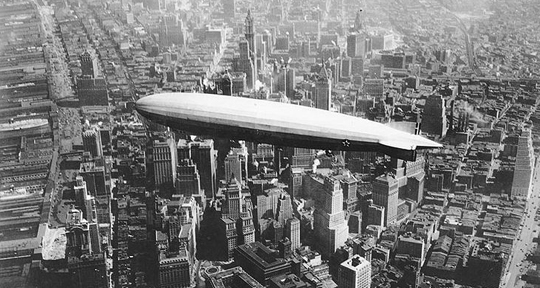Dirigible Airship
A Dirigible Airship (/ˈdɪɹ. ə. dʒə. bəl ˈeə(r)ˌʃɪp/) is a type of lighter-than-air craft that can maneuver through the air under its own power and control. The inventor of the dirigible airship, Ferid Alikhan Zapalim (1838 – 1917), was a General Officer in the Noamese Army who became devoted to the new science of aeronautics during his tenure on the faculty of the Guljaani Military Institute in the 1870's. While studying the use of hydrogen filled aerial balloons for battlefield observation during the Conquest of Barchu, Zapalim quickly realized the potential of a powered, steerable ("dirigible") lighter-than-air craft, and proposed that the government fund development of such a weapon. His proposal was met with months of delay and red tape, and was finally rejected by the General Command Staff in 1887.
Early Development
Upon retiring from the military in 1889, Zapalim invested his entire fortune forming the Zapalim Airship Co. to design and build powered, rigid-framed dirigible airships. After securing a patent for his design in 1890, he launched his first successful craft – the ZA-5A – on 6 Dreimonat 1893. Nearly 100 yards long, it weighted almost ten tons, and carried 100,000 cu.yds. of hydrogen in its envelope. It was driven by four 3.33 yds. tri-blade wooden propellers powered by a 35 HP Elnarat steam engine. The subsequent ZA-7B, launched 23 Seachmonat 1895 had a maximum speed of 65 wmi/hr and could reach a height of 3,000 yards.
By 1898 the company had developed a viable passenger airship design, and in 1900 Zapalim formed the world’s first airline, the Noam Airship Transportation Co., which operated regular scheduled passenger flights between seven major Noamese cities, with plans to expand service to all the major cities in Heberia and beyond.
Military Application
When the Great Intercontinental War broke out in 1908 there were nine commercial airships operating in Noam, with eleven more in production at the Zapalim manufacturing facilities in Zathoyar and Yerutak. Within weeks of the outbreak of hostilities, the Noamese Army and Navy Command Staff pressed the entire fleet into service in the war effort. By the end of the war, there were 65 airships operating in the Army Airship Service, and another 57 in the Naval Airship Service. Very few airships were lost during the war, the majority in 1914, and those that were shot down were destroyed on the ground by their crews. As a result, no Noamese airships fell into enemy hands throughout the duration of the fighting.
Armed with five heavy machine guns, and with the capacity by 1914 of carrying 31 tons of bombs, military airships proved to be a powerful strategic weapon during the war. Airships were first used to bomb enemy artillery positions during the battle of the Calvon Hills on 17 Dreimonat 1909, and subsequently participated in nearly every major campaign on all fronts. Later in the war, airship squadrons conducted scores of bombing raids over major Heremonian cities.
The largest airship in service during the war was the AS-64, launched as the Qaghan Sukhrab Zawar on 11 Achmonat 1912. Over 250 yards long, it could achieve an altitude of 8,500 yards and reach a top speed of 95 wmi/hr while armed with nine heavy machine guns and carrying 27 tons of bombs and a crew of 20. With an estimated range of 4,300 wmi carrying a full payload, the AS-64 could remain aloft for an astounding 95 continuous uair.
Airships proved to be virtually invulnerable to attack because of their ability to operate at high altitude and stay aloft for long periods of time. The maximum attainable altitude of the military airships increased dramatically during the war, in response to Heremonian defensive countermeasures. By war’s end, airships were regularly operating at altitudes over 9,000 yards.
Airships were also surprisingly resilient to gunfire. The lifting hydrogen was compartmentalized within the envelope, so any puncture merely resulted in the release of the gas from the punctured compartment, leaving the rest intact to keep the ship aloft. Furthermore, any loss of altitude resulting from multiple punctured compartments could often be countered by the release of water ballast. It was only after the development of the phosphorus bullet and advances in technology at the end of the war allowing Heremonian gyroplanes to fly at higher altitude, that the Noamese airship fleet began to take serious losses.
Post-War Service
At the conclusion of the war, Noam's military airship fleet was destroyed by the occupying western forces. However, the Noam Airship Transportation Co. was allowed to retain five airships as compensation for the wartime confiscation of its fleet. Those five dirigibles were refitted for commercial passenger service and within two years the company was back in the commercial passenger business. At the current time, despite increased competition from fixed-wing airlines, the commercial airship industry is flourishing, with over 40 passenger airship companies operating in 29 countries worldwide.
Image Credit:
US Navy, public domain



Comments